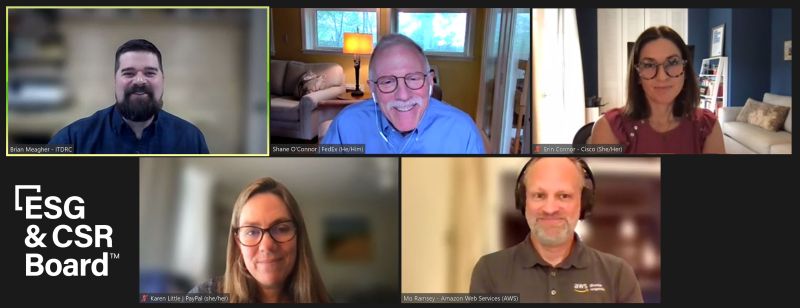Key takeaways:
- Strategic Communication: It’s important to effectively communicate with employees when not directly responding to a disaster, utilizing programs like gift matching.
- Long-term Recovery: Acknloweding that your enterprise is not a humanitarian organization, focus on partnerships to aid in long-term support and recovery well beyond the immediate aftermath of a disaster.
- Responsible Branding: It’s paramount to balance external marketing and with extreme sensitivity. Lean on your partners to publicize your work and ensure the focus remains on genuine relief efforts rather than public relations.
During a recent ESG & CSR Board live panel, Future-Proofing Your Disaster Relief Strategies, corporate responsibility leaders shared how they’re adjusting their disaster strategies in anticipation of more frequent and severe disasters.
Let’s explore some of the most pressing questions the audience had on supporting long-term recovery initiatives, finding opportunities for corporate collaboration, designing a communications strategy, and more.

Q: How do you communicate with employees when as a company, you won’t be responding to a disaster or crisis?
Today, more disasters occur than any enterprise can reasonably respond to, but fielding questions from employees or other stakeholders can be difficult in these scenarios.
Cisco Director of Crisis Response Erin Connor explained how they manage this by redirecting employees to the company’s matching gift program, which matches up to 25,000 per employee annually and 40 hours of volunteer time off per year.
“Even if we’re not launching a campaign, very few employees actually hit that max,” Erin said.
Karen Little, Senior Lead, Rapid Response and Strategic Partnerships at PayPal, noted that they never decided until the end if they’ll directly respond to a disaster. When communicating with employees, she shared that the team typically uses the language, “We’re not currently responding, but we’re continuing to monitor.”
Q: How do you approach long-term recovery initiatives to provide support months after a disaster?
The Center for Disaster Philanthropy states that about 80% of charitable giving occurs in the first 72 hours after a disaster, but we know recovery support is needed much further down the line.
Maurice Ramsey, Global Leader of Disaster Response and Humanitarian Affairs at Amazon Web Services, said, “I think the first thing that’s important for us to say out loud is that we are not a humanitarian relief organization. It helps us to make sure that people understand the guardrails when we are getting into these long-term disasters.”
FedEx Communications Advisor Shane O’Connor said, “Because of our 600-plus airplanes, the relief aspect is really the one that fits best for us because we can get stuff where it needs to go the next day.”
While your organization may not be directly involved in on-the-ground efforts during the months or years following a disaster, nonprofit organizations are. Shane mentioned that FedEx supports long-term recovery by partnering with partners such as Team Rubicon, a veteran-led volunteer organization.
Similarly, Karen shared how PayPal has aided small businesses affected by the Afghan refugee crisis and the war in Ukraine through a partnership with the International Rescue Committee.

“I think the first thing that’s important for us to say out loud is that we are not a humanitarian relief organization. It helps us to make sure that people understand the guardrails when we are getting into these long-term disasters.”
Maurice Ramsey, Amazon Web Services
Q: How do you balance the external marketing aspect of disaster relief without appearing like you’re taking advantage of a bad situation?
Branding and public relations are not the focus areas of a corporate disaster response strategy, but they shouldn’t be ignored either.
Maurice said, “We don’t work at the direction of PR or marketing. We don’t exist for stories, but those things are unintended consequences.”
He shared that they’re very careful of what information they release and how they release it. The public will only see a select handful of AWS’ disaster response activities, and the aim is to communicate high-level messages, typically through blog posts.
Additionally, Maurice said they will often leave it to their nonprofit partners to publicize their co-deployments. “These are not our stories to tell anyway,” Maurice said.
During the panel, Erin added that Cisco employees are often the primary audience when communicating disaster response efforts, in part because of the impact on morale and retention.
There’s also an appropriate time and place to publicize this information, and panelists agreed it’s typically following a disaster rather than during.

“Our team is pretty careful around not publicizing anything when we’re responding. Not to look like we’re ambulance chasing or trying to take credit when in the face of incredible suffering.”
Erin Connor, Cisco
Q: What are the opportunities for corporate collaboration to aid in disaster relief efforts?
Whether it’s FedEx’s planes or Amazon Web Services’ technology, each organization possesses unique skills, expertise, and resources that can aid recovery efforts. Corporate partnerships can help fill gaps in the disaster relief space.
“There are things that we are maybe not so great at,” Maurice said. “We want to make sure that we are enabling other organizations to cover that in their response activities.”
Karen added, “I think this is a space where we can be doing even more together. Maybe it’s supporting certain partners where we overlap, or maybe we’re doing something to feature them for our customers. I think there’s even more we could be doing here to maximize some of the impact we can all have together.”
When it comes to coordinating with other organizations, panelists mentioned leveraging a tech-sector disaster working group via WhatsApp, Center for Disaster Philanthropy, Information Technology Disaster Resource Center, and the ESG & CSR Board.
“In terms of coordinating with other corporations and our peers in this field,” Erin said. “I think the ESG & CSR Board has provided a really great forum to be able to ask questions so that people can respond quickly.”
Gain More Insights from Senior CSR Leaders
Panelists had a lot more to say about corporate disaster response strategies. Catch all the insights shared by ESG & CSR members by watching the panel recording here.
To gain more insights on disaster response and corporate giving, join our members who meet regularly to benchmark their strategies.


